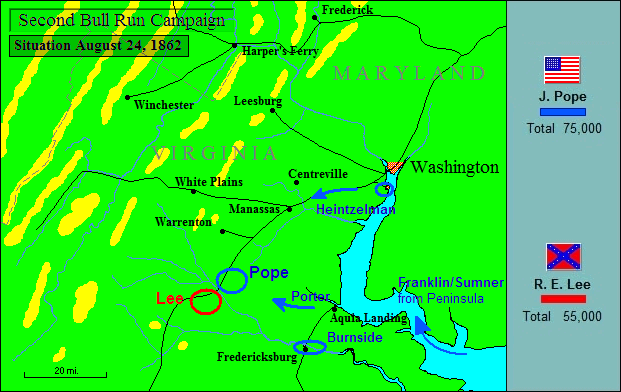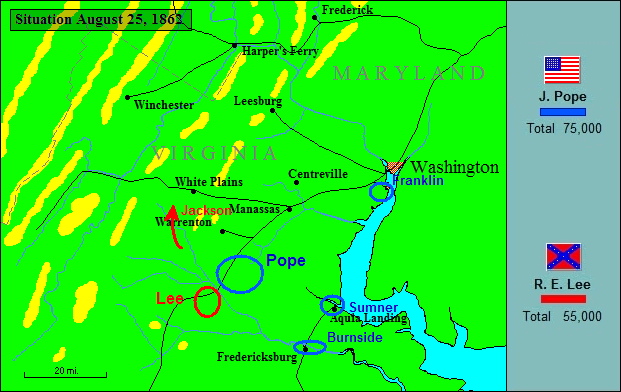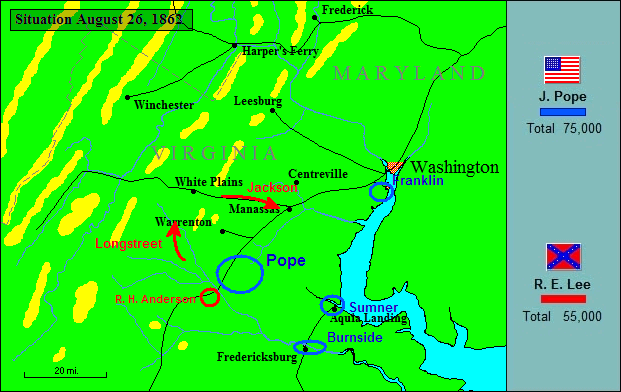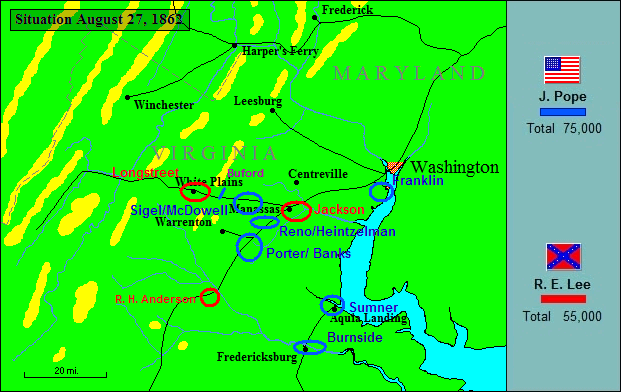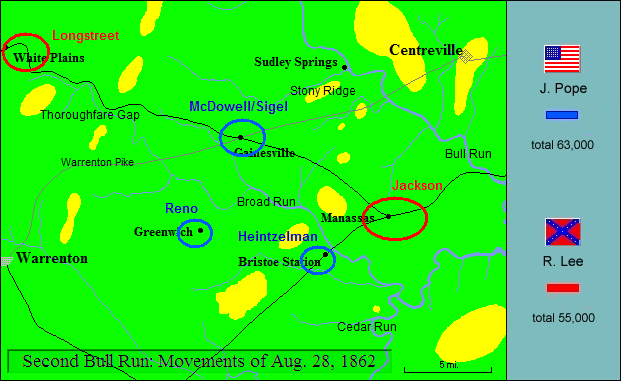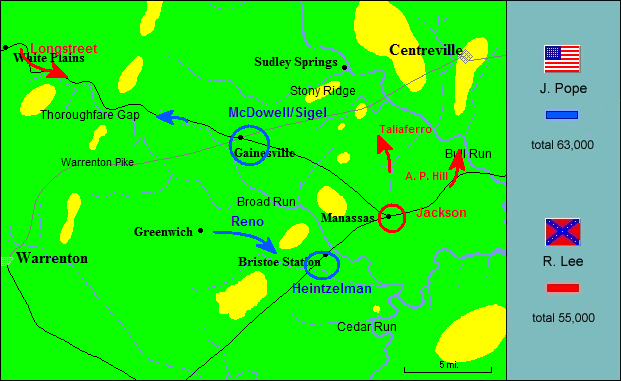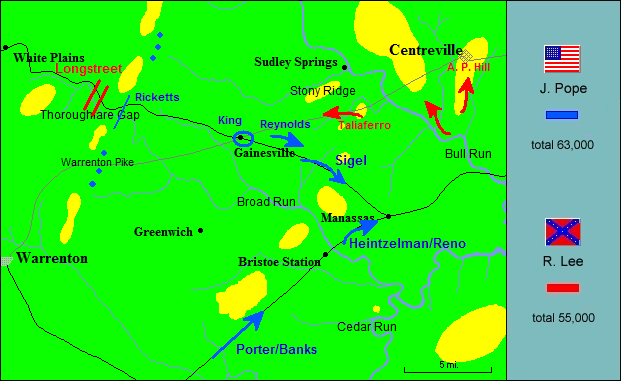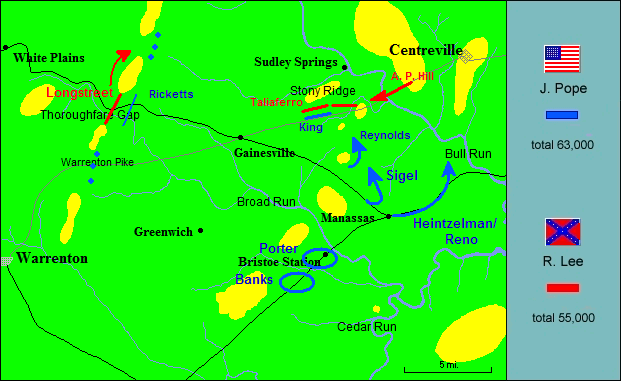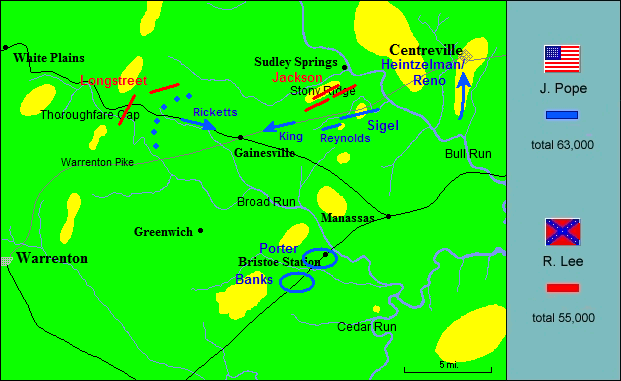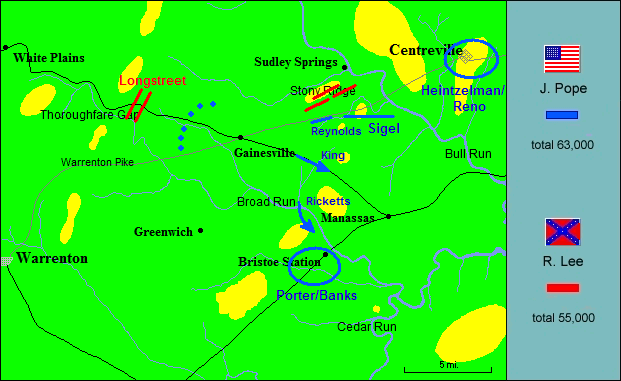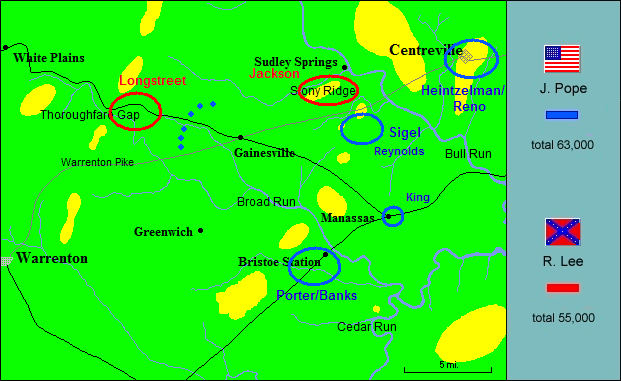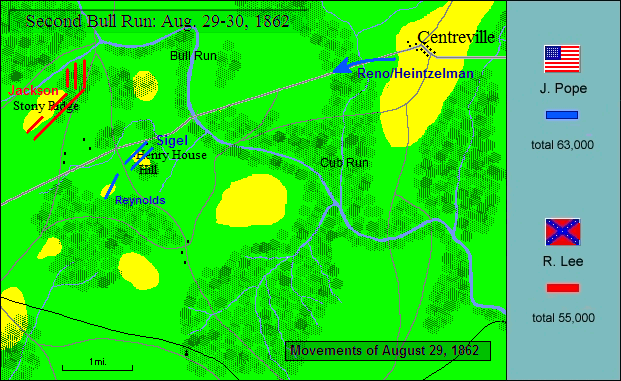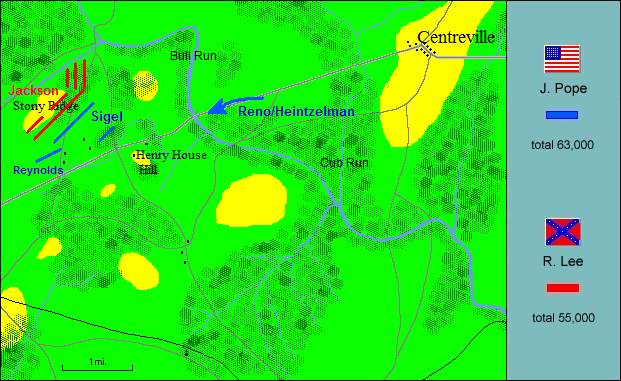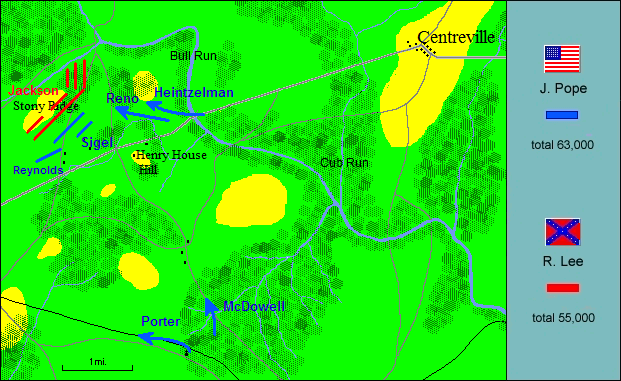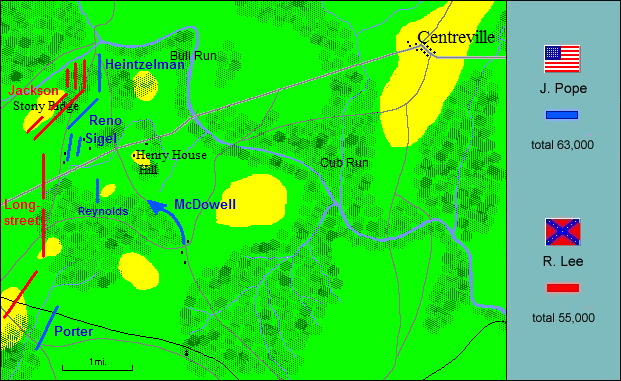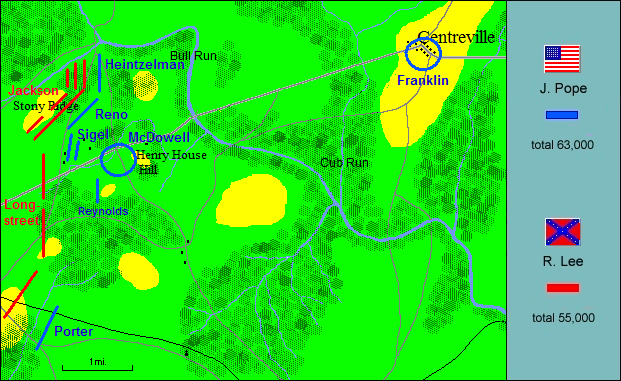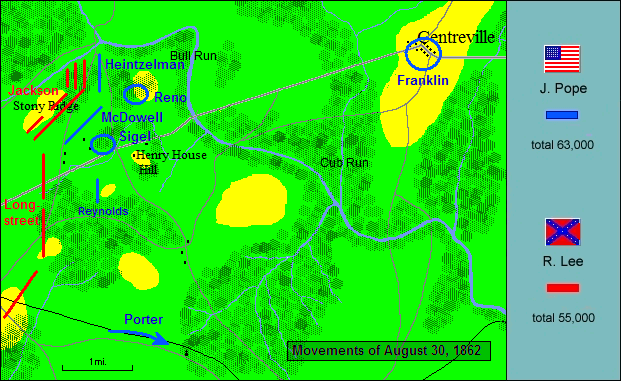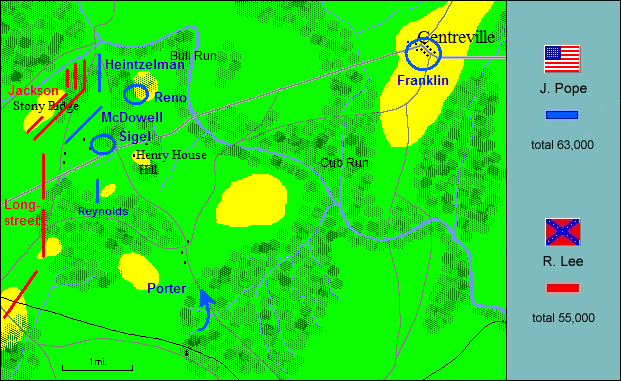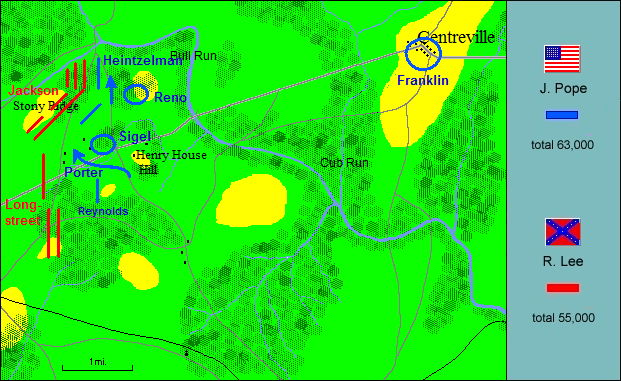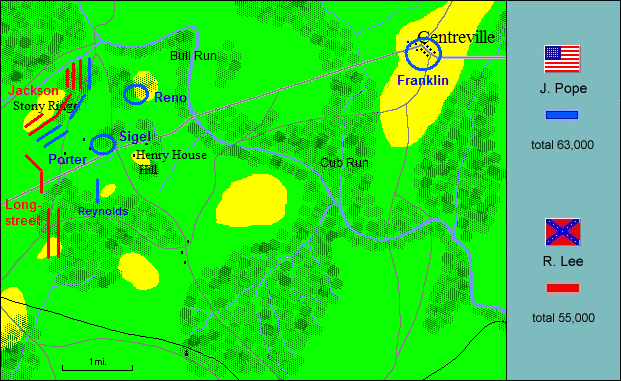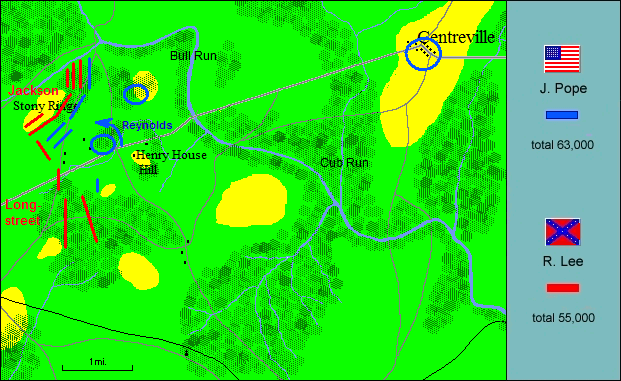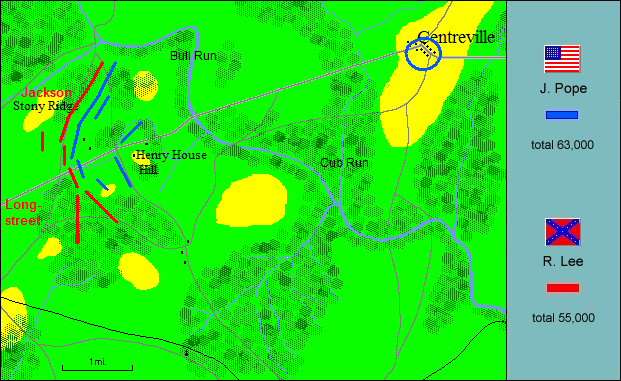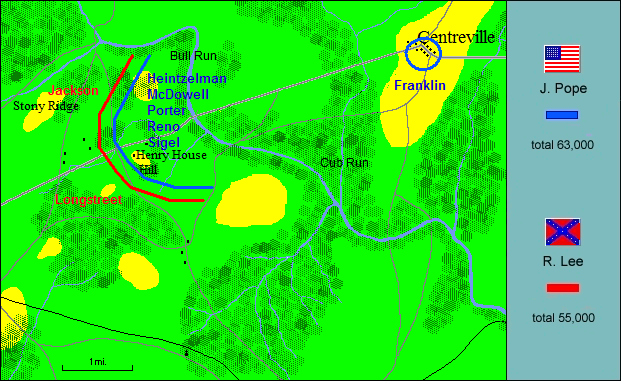I have come to you from the West, where we have
always seen the backs of our enemies…
–John Pope, to the Army of the Potomac

Pope’s situation in northern Virginia was on the face of it promising. He was well supplied and in force on the line of the Orange and Alexandria railroad, and McClellan was still on the Peninsula threatening Richmond with his 100,000-man army. Between them was Lee with a force half their combined total. If Henry Halleck, recently called from the West to serve as general-in-chief, could coordinate the operation of these two armies, Lee might be crushed between them.
Pope’s first step, however, was not promising. It was to deliver a bombastic speech to his army, insulting and alienating its officers and men. It read in part: “Let us understand each other. I have come to you from the West, where we have always seen the backs of our enemies; from an army whose business it has been to seek the adversary and beat him when he was found… Dismiss from your minds certain phrases, which I am sorry to find so much in vogue amongst you. I hear constantly of ‘taking strong positions and holding them,’ of ‘lines of retreat’ and ‘bases of supplies.’ Let us study the probable lines of retreat of our opponents, and leave our own to take care of themselves. Let us look before us and not behind. Success and glory are in the advance, disaster and shame lurk in the rear.” It is not hard to see why one of Pope’s brother officers frankly admitted that he did “not care a pinch of owl dung” for John Pope.
Indeed, John Pope did not need to make enemies in his own camp just then because confronting him were three men who would ultimately make the general think very hard about his own base of supplies and line of retreat: Robert E. Lee and his two corps commanders, James Longstreet and Stonewall Jackson. (Lee had recently reorganized the Army of Northern Virginia, the Seven Days having demonstrated the difficulty of communicating directly with each division.) For his part, Lee held Pope in personal contempt for his severe treatment of Southern civilians. To Lee, he was a “miscreant” who must be “suppressed.” Convinced that McClellan would not soon resume the offensive on the Richmond front, Lee detached first Jackson with 13,000 men on July 13, then A. P. Hill with 12,000 on July 27, with orders to concentrate on Gordonsville and counter Pope’s threat there. Jackson with 25,000 was more than enough to worry cautious Henry Halleck. Despite his sluggish performance in the Seven Days, Stonewall was still a terrible name in the Federal camp. Since it was clear enough in Washington that McClellan was not going to do much with the Army of the Potomac, Halleck began–over Little Mac’s vehement protests–to send elements of it to reinforce Pope. These, however, had to go the way they came–by transport across the Chesapeake and up the Potomac. Lee, for his part, intended to strike Pope a blow before the bulk of the Army of the Potomac could reach him. In this design, he would receive aid from an unexpected quarter. McClellan, who despised that “villain” Pope, was in no hurry to execute Halleck’s order to reinforce him. In the end two entire corps never reached Pope in time to be useful for no other reason than the fact that McClellan refused to carry out orders expeditiously. In letters to his wife McClellan appears deeply satisfied by the prospect of his rival’s defeat.
Leaving 20,000 troops in front of Richmond, Lee and Longstreet moved with the main body of the army to Gordonsville on the Virginia Central railroad and turned to the business of suppressing John Pope. There had already been one collision in the campaign. At Cedar Mountain, due north of Gordonsville, two of Pope’s advance divisions ran into Jackson on August 6. These, it happened, were commanded by Nathaniel Banks, who had been so badly used by Jackson in the Valley back in May. Hoping for a measure of revenge, Banks struck. He got a measure but no more. His attack broke and drove Jackson’s old Stonewall Brigade, but Hill’s counterattack sent him flying back to join Pope now behind the Rappahannock River. At this point, Lee showed why some called him Audacity. In the face of an enemy in force, Lee divided his army. Jackson’s corps would swing northwest on a wide flanking march behind the screen of the Bull Run Mountains and fall on Pope’s line of supply and communications well in his rear. On August 25, Pope first learned Jackson was in motion north of the Rappahannock, but supposed he would turn west toward the Valley. The next thing he knew, however, Jackson’s “foot cavalry” were twenty-five miles in his rear foraging freely on the mountain of Federal supplies at Manassas Junction. Whatever had ailed Jackson in the Seven Days clearly no longer ailed him. His corps had marched north to Salem, turned east through the Thoroughfare Gap, and hiked down the railroad to Manassas: a march of fifty miles in two days. After burning what they could not carry, on the 28th they took up a strong position just west of the old Bull Run battlefield.
The position ran two miles along an unfinished railroad embankment backed by a long wooded ridge. It was just north of the Warrenton Turnpike by which Lee and Longstreet were soon to come to Jackson’s aid. Their timely arrival was important because Pope was in the neighborhood with 60,000 men and more on the way–more than twice Jackson’s numbers. Jackson, however, had always preached the doctrine of mystifying the enemy, and just then Pope was very thoroughly mystified. When he learned that Jackson was in his rear, he got his army in motion toward Manassas, but by the time he got there, he found nothing but the ashes of Jackson’s feast. Pope pushed on to Centreville with no better luck. Then, at dusk on the 28th, the mystery of Jackson’s whereabouts was solved. A luckless Yankee division under Rufus King ran into Stonewall’s elusive corps west of Bull Run by accident, and a fierce twilight battle ensued, ending in a draw in the darkness. In his abrasive address to the army, Pope had spoken of seeking the adversary and beating him when found. Now he had found him; the next day, he swore, he would “bag the whole crowd.” Unfortunately for Pope, his clumsy pursuit of Jackson had led him to a decidedly wrong-headed conclusion: he believed that Jackson was in headlong retreat. If he didn’t act quickly, he reasoned, Stonewall would escape.
Thus, on August 29, instead of waiting to concentrate his whole force for one determined blow, Pope sent his attack forward with what he had. First, Franz Sigel’s division, 11,000 strong, struck the center of Jackson’s line, but punishing rifle and artillery fire broke up the Yankee brigades. Although they reached and held a portion of the embankment briefly, they were driven back, pretty much spent for the day. By this time elements of the Army of the Potomac were reaching the field–Phil Kearney, Joe Hooker, and Jesse Reno with 20,000 veterans in all. Now Pope sent them forward to smash up Jackson’s left near the Sudley Springs ford. Had the attack been better organized and fallen with one hard shock, it might well have succeeded. As it was, A. P. Hill’s Light Division took a vicious pounding but was not quite broken. In many places the fight was hand-to-hand, and when Hill’s men ran low on ammunition, they hurled rocks at their attackers. At dusk, as the Rebels were preparing to hold the position with the bayonet, the Federals, themselves exhausted, broke off the attack. Despite heavy losses, Hill had made good on Jackson’s boast: his men might sometimes fail to take a position, but they never failed to hold one.
Hill and Jackson owed a measure of thanks to Pope himself actually. Although he had struck Jackson with 30,000 men, he had on hand another 30,000–the two corps of McDowell and Porter–who never got into the fight that day. In fairness to Pope, it wasn’t because he hadn’t sent them; McDowell and Porter had been ordered to march to Gainesville on Jackson’s right and fall on his flank while Kearney’s attack was pressing his left. But McDowell unaccountably spent the day going the long way around, and all he accomplished was a brief skirmish in the dark. Incredibly, even this was more than Fitz-John Porter achieved, which was absolutely nothing. Porter was a crony of McClellan and shared his intense antipathy for Pope. That resentment may have been the motive for what he did next: he marched toward Gainesville, saw a column of Confederates coming up on Jackson’s right, and, calling a halt, spent the whole day resting two miles from the Federal left while his comrades fought a furious battle. It was not the finest hour of the Federal high command.
But it fell to John Pope to make a final, fatal error. The column of Confederates Porter had seen was Longstreet’s corps, which had followed Jackson’s route behind the Bull Run Mountains, through undefended Thoroughfare Gap, and down the railroad to the Warrenton Turnpike. Pope in his urgent efforts to catch Jackson–who was after all not going anywhere–seems to have forgotten about Longstreet’s five divisions now in line on Jackson’s right and well beyond the Federal left. On the night of the 29th, Hill, in a move to straighten his line, withdrew some of his brigades from an advanced position. For Pope, the move confirmed what he had wanted to believe all along, that Jackson was retreating. First, he wired to Washington news of his victory–yet another complete victory that was not to be. Then he gave orders to renew the attack the next morning with his whole force. Part of his army would again pitch into Jackson; the rest would drive west up the turnpike in pursuit of the retreating Rebels. Not until noon did the attack get off, but when it did, it struck hard on Jackson’s front–so hard that Jackson was forced to call on Lee for reinforcements from Longstreet’s corps. Lee had wanted to send Longstreet in on the Union left the day before, but Longstreet, a redoubtable but deliberate fighter, had persuaded him to wait and see how the situation developed. Now the situation was all Old Pete might have wished for. To give weight to the attack on Jackson, Pope had been forced to shift troops to his right. As a result, there were hardly any Federals in front of Longstreet, and he was squarely on the flank of the attack on Jackson’s front. Longstreet now rushed his field guns forward and blasted that attack to pieces in a deadly enfilade. Then he launched an attack of his own: all five divisions driving east on the south side of the turnpike. For Pope, it was now a question of defeat or complete disaster. If Longstreet’s men reached the old Stone Bridge over Bull Run before he could secure it, his whole crowd would be bagged.
Although initially stunned by the shock of Longstreet’s assault, the Federals fell back stubbornly. Pope managed to shift units to his shattered left, and these succeeded in taking some of the steam out of Longstreet’s drive. By evening, Yankees on the left made a stand in front of Henry House Hill–where Jackson had earned his famous name the summer before–and after a furious fight, Longstreet’s drive was finally blunted. A Virginia soldier remembered the “frenzied struggle in the semi-darkness… so violent and tempestuous, so mad and brain-reeling that to recall it is like fixing the memory of a horrible blood-curdling dream. Everyone was wild with uncontrollable delirium.” On their right, Jackson’s counterattack drove the Federal line east toward Bull Run until it too ground to a halt toward dusk. The battle went on a while in the twilight, but the Yankees could not be dislodged. Their line had been bent into a fishhook two miles long, but they had saved their bridge and their army.
On the night of August 30, Pope–all braggadocio gone–was compelled to show his back to the enemy, and withdrew his exhausted, fought-out army back to Centreville. It had suffered 16,000 casualties. Acres of wounded lay on hay in the dark receiving such mercies as Clara Barton, later founder of the American Red Cross, and a handful of others could administer. At Centreville, Pope’s men had some good news: reinforcements–William B. Franklin’s corps from the Peninsula–were just coming up. But even this welcome news had a painful edge. Franklin’s men were ardent McClellan partisans, and like their hero, they delighted in Pope’s defeat. As one officer remembered it, “they greeted us with mocking laughter, taunts and jeers on the advantages of the new route to Richmond; while many of them in plain English expressed their joy at the downfall of the braggart rival of the great soldier of the peninsula.” There is no record of anyone doing Pope’s men the simple justice of recognizing that they had fought very well and had been very badly led.
Lee’s army had suffered 10,000 casualties of the 55,000 engaged, but Lee was not quite through with Pope. Although the Yankee line at Centreville was too strong to assault, it might be possible to swing Jackson around on another flank march and strike the Yankees in their rear. Jackson’s bone-weary men splashed across Bull Run at the Sudley Springs ford and pushed north, but not even so remorseless a driver as Jackson could get much out of them. Hungry and slogging the muddy roads, they ran into two Yankee divisions near Chantilly, a country estate just north of Centreville on September first. Late in the day as a thunderstorm broke over their heads, the Yankees attacked. It was a bitter little battle, fought to a draw when the rain came down so hard that neither side could see the other, and accomplished little except to lengthen the casualty lists. Among the fallen were two very capable Union brigadiers, Issac Stevens and Phil Kearny. Kearny had ridden accidentally into a Confederate skirmish line and was shot in the back. “Poor Kearny!” said A. P. Hill, a prewar friend, “he deserved a better death than that.” Under a flag of truce, his body was sent through the lines.
Longstreet remained on the battlefield to gather up his wounded and bury the dead, who had paid the price of his astonishing victory. When the summer began, McClellan had been at the gates of Richmond. Now in September Lee was in triumph twenty-five miles from Washington. In June, he had driven McClellan off the Peninsula in a week of furious fighting. Now in August, he had thoroughly routed Pope–on the very field where the Yankees had been routed the summer before. News of Second Bull Run sent shock waves of discouragement and disillusionment throughout the North. A New York lawyer, George Templeton Strong, gauged the country’s mood in his diary: “The nation is rapidly sinking just now… Disgust with our present government is certainly universal.”
As for the Lincoln government, it had good reason to be disgusted with the army. Vainglory and rivalry had led to poor performance from nearly everyone at the top–Pope, McDowell, Porter, and McClellan. To Lincoln fell the task of picking up the pieces of the disaster. He sent Pope west to Minnesota to fight the Sioux; he relieved luckless McDowell; in November, Porter was court-marshaled and cashiered. McClellan, however, presented a knotty problem. On the one hand, Lincoln was convinced that McClellan had in fact “acted very badly in the matter,” had “wanted Pope to fail” and by his lack of cooperation had helped him to fail. By rights, he ought to be relieved, too. On the other hand, the army he had made out of the wreckage of First Bull Run was deeply, passionately, even mysteriously devoted to him. On September 2, that army was stumbling back to Washington in a cold rain just as they had more than a year before. “Everything bore a look of sadness in unison with our feelings,” one soldier wrote, “Here were stragglers plodding through the mud… half-formed regiments, part of the men with guns, part without… everyone you met looked as if he would like to hide his head somewhere from all the world.” Then in the gloom word came that Little Mac was at hand: “Enlisted men caught the sound!… From extreme sadness, we passed in a twinkling to a delirium of delight. A Deliverer had come… Shout upon shout went out into the stillness of the night and as it was taken up along the road and repeated by regiment, brigade, division, and corps, we could hear the roar dying away in the distance… The effect of this man’s presence on the Army of the Potomac… was electrical, and too wonderful to make it worthwhile attempting to give a reason for it.” Although Lincoln admitted to being “greatly distressed” to have to turn to McClellan again, he did so. “We must use what tools we have,” he told Stanton. McClellan, the Deliverer, wrote to his wife: “Again I have been called upon to save the country.”

